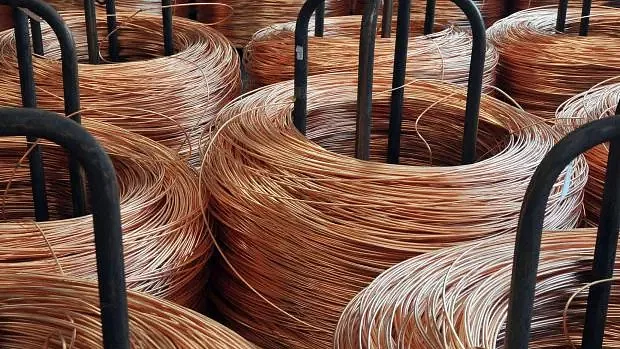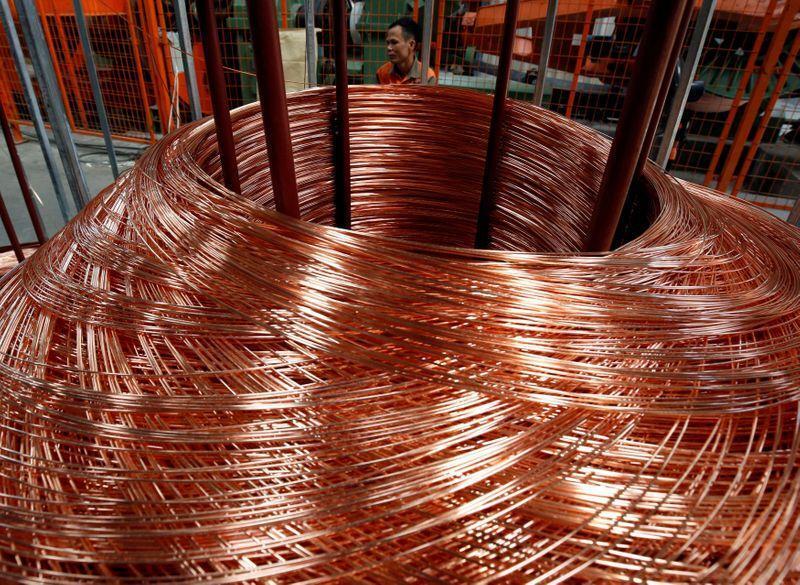Global copper market deficit for Jan sept widens to 295000 tonnes.

On Wednesday, three-month copper on the London Metal Exchange was trading at about $7,363 per tonne, having fallen more than 30% as recessionary worries grew since reaching a record high of $10,845 in March.
According to the International Copper Study Group (ICSG), the global copper market will have a deficit of approximately 325,000 tonnes this year and a surplus of 155,000 tonnes in 2023.
In a statement, the company stated that “continued COVID-19 related restrictions and workforce absenteeism, operational and geotechnical issues, strikes, water restrictions in Chile, lower than anticipated head grades, and community actions in Peru have constrained mine output at a number of operations this year.”
On Wednesday, three-month copper on the London Metal Exchange was trading at about $7,363 per tonne, having fallen more than 30% as recessionary worries grew since reaching a record high of $10,845 in March.
According to the ICSG, global apparent refined copper consumption is anticipated to rise by 2.2% in 2022 and 1.4% in 2023.
“A downward revision to refined usage growth for both 2022 and 2023 has resulted from a deterioration in the global economic outlook, primarily as a result of elevated energy prices and high inflation,” the Group said.
More about the global Copper market
According to the ICSG, global refined copper production will increase by roughly 2.8% in 2022 and 3.3% in 2023.
Monday saw a decline in copper prices as protests against China’s strict COVID-19 curbs added to concerns about the country’s demand. However, a weaker dollar helped to support sentiment.
On the London Metal Exchange (LME), the benchmark copper price traded down 0.3% to $7,980 per tonne in official rings.
As protests against China’s strict COVID restrictions flared for a third day and spread to several cities, hundreds of protesters and police engaged in violent altercations in Shanghai on Sunday night.
“What will the Chinese government do in response? How long will the protests last? Regarding China, there is a lot of uncertainty “said one metals trader. “Growth is sluggish and the outlook is worse in Europe and the United States.”
Surveys of purchasing managers in China’s manufacturing sector, where activity is anticipated to have decreased further this month, will be closely examined by industrial metals markets.
The Chinese government has put in place a number of initiatives to boost growth, but the recovery has been hampered by COVID issues and a slowdown in the global economy.
A weaker dollar makes metals priced in dollars more affordable for holders of other currencies, which could increase demand. Funds use this relationship to produce buy and sell signals from mathematical models.
Rising stocks (MCUSTX-TOTAL) in LME registered warehouses, which have increased by 17% since November 10 to 91,200 tonnes, have recently put pressure on copper prices. From 50% earlier this month, a metal that is not yet scheduled for delivery and is available to the market has increased to 84% of all stocks.
Cash metal prices for the three-month contract CMCU0-3 are now lower due to diminishing concerns about copper supplies on the LME market after being higher in August, September, and October.
While this is happening, attention is shifting to stocks with 15-year lows, large holdings of warrants and cash contracts, and the discount for cash lead over the three-month contract, CMPB0-3.
Lead for three months decreased by 0.1% to $2,115 per tonne.
Tin increased by 0.1% to $22,250, aluminium fell by 0.4% to $2,353, zinc fell by 0.4% to $2,908, and nickel fell by 0.5% to $25,300. (Pratima Desai reported; David Goodman edited.)
Price cap decisions for energy
The oil market’s mood is still gloomy, and the weekend’s events in China won’t change that. As Covid cases in China continue to rise, some cities have tightened their restrictions on mobility. Reports of Covid protests in China will probably be negative for public opinion.

One only needs to look at the price movement to see that investor enthusiasm has decreased recently. Positioning information further supports this claim. Speculators’ net longs in ICE Brent were down by 70,502 lots over the past reporting week, according to the most recent exchange data, leaving them with a net long of 138,048 lots as of last Tuesday.
Since August, this is the lowest position held. The persistent uncertainty surrounding Russian supply doesn’t seem to be causing the market any concern. Instead, the demand story appears to be the sole topic of discussion.
The US government loosened its oil embargo against Venezuela over the weekend, allowing Chevron to resume oil production at some of its joint ventures there. Given that the volumes will be relatively small, the loosening of sanctions will only have a minor effect on the market. Additionally, it appears that the easing permits the export of this crude to the US. For US refiners looking for heavier grades of feedstock, this will be useful.
In the coming week, we should start to receive some estimates of OPEC members’ November production levels. This will undoubtedly provide valuable insight into which members have cut back on production in line with the most recent OPEC+ supply cuts. Back in October, OPEC+ decided to cut their production goals by 2MMbbls/d starting in November.
However, this week’s price cap developments will probably be closely watched by the market. Last week, attempts by EU members to reach a consensus on the price cap for Russian oil fell short. Before the EU ban on Russian crude oil transported by sea takes effect on December 5th, the EU and G-7 will want to reach an agreement this week. The Commission last week suggested setting the cap at EUR275/MWh, which some members believe is too high, so EU members will also need to come to an agreement on this.
Metals: China’s aluminium stockpile is declining.
According to the most recent information from the Shanghai Metals Market (SMM), as of Friday, inventories of aluminium ingots were at 51.8 kt, the lowest level in nearly six years, a 10% decline over the previous two weeks.
In order to reduce emissions, smelters in northern China are reducing output during the winter, according to SMM, while the restart of plants in the southwest (whose operations had to be suspended due to power shortages) has gone more slowly than anticipated. According to the most recent information from the Shanghai Futures Exchange (ShFE), aluminium inventories on the market decreased by 15 kt (-12% WoW) to 110 kt, which is the lowest level since 2017.
With regard to copper concentrate supply agreements for 2023, US miner Freeport-McMoRan and the Chinese copper smelters Tongling Nonferrous Metals Group Co. and Jiangxi Copper Co. reached an understanding in which treatment fees would be set at US$88/t (+35% YoY).
The higher treatment costs are a sign that smelting capacity will be able to handle expected increases in mine supply. According to some estimates, once two large mines, Quellaveco in Peru and the Quebrada Blanca 2 project in Chile, are fully operational, the market will receive an additional 616 kt of copper.

According to the International Copper and Study Group’s most recent monthly report, the supply deficit for copper decreased to 10 kt in September from a deficit of 13 kt in August.
The copper market experienced a deficit of 295 kt over the first nine months of the year as opposed to 233 kt during the same period in 2016. Global mine and refined copper production rose by 3.5% YoY and 2.3% YoY, respectively, for the period of January to September 2022, while overall apparent refined demand increased by 2.6% YoY.
Agriculture: Reduced Argentine wheat production
According to the most recent information from a crop tour conducted by the Bahia Blanca Grain Exchange, drought and frost conditions will cause wheat production in Argentina’s southern Buenos Aires and La Pampa provinces to decrease by 31% YoY. The survey predicts that the region’s wheat harvest, which begins next month, will be about 3.7 million tons (mt), down from 5.3 million tons the previous year. The region’s production of barley is anticipated to fall by 20% YoY to 2.3mt.
Edited by Prakriti Arora




